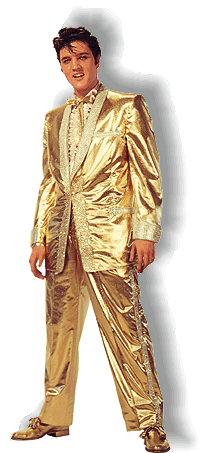 www.elvis.com
www.elvis.com |
Film, Audio and Video Terminology - Part 3 of 3
In discussing Elvis' movie and recording career, we often come across
terms not readily understood by the layman. This week is the last of our
three-part series of EFOW newsletters devoted to learning about some of
the specialized terms used in the entertainment industry:
PAY OR PLAY: A contract provision which commits the production company
to compensate a cast or crew member for a project whether or not that
project ever goes into production.
PICK-UP SHOT: Reshooting a portion of a scene, the rest of which was
acceptably filmed in a previous take.
POST-PRODUCTION: The period in a project's development that takes place
after the picture is delivered, or "after production". This term might
also be applied to video/film editing or refer to audio post-production.
PRINCIPLE PHOTOGRAPHY: The main photography of a film and time period
during which it takes place.
PROP: Anything used or touched by the actors on a set.
PROPERTY MASTER: Person responsible for buying, acquiring or making
props.
RELEASE: The general distribution of a film for public exhibition.
RE-RECORDING: The process of mixing all edited music, effects and dialog
tracks of a film or video production to mono, stereo, multi-channel or
whatever audio format is desired for the final print master.
ROUGH CUT: A preliminary trial stage in the process of editing a film.
Shots are laid out in approximate relationship to an end product without
detailed attention to the individual cutting points.
RUN OF THE PICTURE: A cast member whose work may be required any of the
days scheduled for principal photography without incurring liability for
additional compensation.
SCORE: The original music composition for a motion picture or television
production which is generally recorded after the picture has been
edited.
SECOND UNIT: A small film crew used to shoot less important parts of the
script, usually crowds or scenery.
SET: An area constructed for filming replicating a room or location.
SET DRESSING: Items of decoration which are not designated in the script
or by the director as part of specific action.
SET UP: Each discrete position of the camera, excluding those in which a
dolly or crane is used to move the camera during filming.
SOUND DESIGNER: A film sound specialist responsible for the development
and augmentation of all soundtrack material, or a significant portion
thereof, and is ultimately in charge of the entire sound production.
Occasionally, it is used to refer to a person who is responsible for
creating unique sound elements which are incorporated into a sound
track.
SOUND EFFECT: A recorded or electronically produced sound that matches
the visual action taking place on screen.
SOUND MIXER: The person responsible for capturing sound as it plays out
live, determining microphone types and placement.
SOUNDSTAGE: An indoor set where sound, lighting, temperature and
security can be controlled.
SOUNDTRACK: Generically refers to the music contained in a film, though
it literally means the entire audio portion of a film, video or
television production, including effects and dialog.
SPEAKING ROLE: A speaking role is one in which the character speaks
scripted dialogue. A non-speaking role is a character specifically
mentioned in the script but doesn't have any lines of dialogue.
STAND-IN: A person about the same size as the actor used during the
setup of a scene.
STUNT DOUBLE: Replaces AN actor for dangerous circumstances in a scene
that requires skills and training to accomplish without injury.
SURROUND SOUND: Sound that is reproduced through speakers above or
behind the audience.
SWEETEN/SWEETENING: Enhancing the sound of a recording or a particular
sound effect with equalization or some other signal processing device.
TAKE: Continuous recorded performance of a scene.
TIME CODE: Also known as Longitudinal Time Code. A high frequency signal
that allows the accurate "locking" of film audio and video equipment.
TRAILER: A short publicity film which advertises a film or forthcoming
presentations.
VOICE-OVER: Narration or non-synchronous dialog taking place over the
action on screen.
WRAP: The span of tape path along which the tape and head are in
contact. More often this refers to securing equipment at the end of the
day or when work is completed at a particular set or location.
(Elvis
and his manager Col. Parker often gave "wrap" parties for the cast and
crew at the end
of the shooting of a movie.)
And that's a wrap on our three-part series on entertainment industry
terminology. |

 www.elvis.com
www.elvis.com